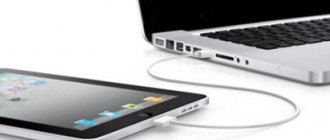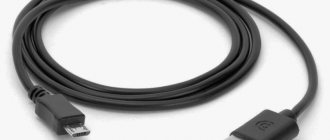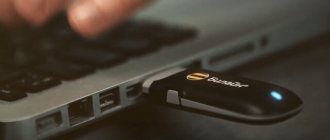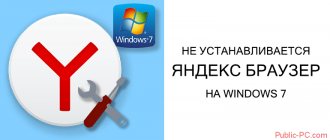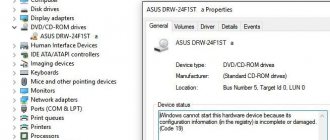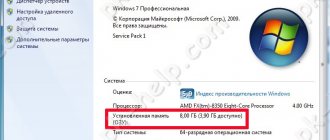Good afternoon friends. In the tenth years of this century, ssd drives appeared, which are becoming increasingly popular over time, as they have many advantages over conventional HDD drives. For example:
- Speed of work;
- Reliability;
- Increased productivity;
- Low energy consumption;
- Silence;
- Low thermal conductivity and others.
But quite often, when you connect this drive, the computer does not see the Windows 7 - 10 ssd drive. Moreover, in most cases, these problems can be easily solved using Windows system software. For example, this happened with my new ssd drive. It simply did not appear in Explorer. Typically, a solid-state drive is not displayed by the system when it simply has not initialized it. In worst cases, the drive is not detected due to BIOS or motherboard incompatibility.
Of course, if the system has not initialized it, then it is not assigned another drive letter, such as C or D. Of course, in this case it will not be recognized in Explorer. Also, it may have a different file system that Explorer does not see. There may be incorrect settings in the BIOS, or you simply connected the disk itself to the motherboard incorrectly (perhaps your motherboard is too old, and such disks are simply not suitable for it). What to do?
You need to initialize the SSD Disk
This was the case in my case. The system simply did not see the disk. What to do in this case? You need to mark it in Windows and assign a letter to it. To do this, call the “Run” command using the “Hot Keys” Win + R. We will have an input line in which we will enter the command compmgmt . msc . After that, click OK.
Next, in the new window, in the left column, select “Disk Management”. Among the drives, select the one that we want to record in the system, right-click on it and find “Initialize disk” in the drop-down menu.
So, put a checkmark above the desired disk, and then put a checkbox above the line “Main boot...”.
After going through this step, let's try to make the section we need. So, right-click on the selected drive (it is marked “Not allocated”) and in the drop-down menu we find “Create a simple volume”.
Next, go to the “Create a New Volume Wizard” and click “Next”.
In the new window we set the required drive size. I advise you not to change anything here, and if you have a 500GB disk, leave the size at 476937, as the system suggests (in fact, the disk is slightly smaller than stated by the manufacturer).
Next, we need to assign the desired drive letter. You can agree with the letter that the system suggests, or choose the one you like best from those suggested by the utility. To do this, click on the triangle above the proposed symbol and select from the remaining ones. I agree with the system and choose N (the letter can then be changed).
The utility changed the volume letter.
The system offers to format the disk, we agree.
Then, the utility specifies exactly how we want to format the disk. I advise you to leave the format that the OS suggested.
We have reached the final stage. The disk is now initialized and should be visible to Windows.
The drive letter is missing
In the “My Computer” section, where all drives connected to the computer are displayed, you can always see what letter or name each of them has. However, there are times when the letter is missing and the SSD is not visible in My Computer. To solve the problem, you need to make sure that the device has a name. More on how to do this.
How to change the hard drive letter?
This applies to all drives, not just ssds. The system may not see your “Solid State Drive” precisely because it is not marked with a letter. Therefore, let's look at how to assign a drive letter. So, let's go into Disk Management again using the same method that I described above. Select our ssd drive, right-click on it, and in the drop-down menu we find “Change drive letter...”.
A new window appears, where we click “Change”.
Click on the triangle on the right side of the window and select the desired symbol from the letters presented. Click OK.
Now, most likely, your ssd will appear in Explorer.
Other BIOS settings
It is unlikely, but still possible, that the BIOS does not see the SSD because the automatic recognition of new devices feature is disabled. Check this point too. When replacing a drive on an old computer, look at what connection interface was used. If it's an IDE, look for the Compatible setting in your BIOS. If it was working in PATA only mode, switch to SATA only mode, otherwise the new SATA drive will not be visible.
Windows doesn't support file system
Does your system still not see the ssd? In this case, it may be that it is formatted in a special system that Windows does not recognize (the system is used to NTFS and FAT32). A similar disk in the “disk manager” may be displayed as RAW. So, let's start fixing the situation.
Enter “Disk Management” as described above. Then, right-click on the desired disk and find “Delete volume” in the drop-down menu. Click on the command.
The system will warn us:
Click “Yes”.
Now, as you can see, the disk has changed its status to “Free”.
After this, we just have to re-create the volume as I described above.
What to do if the new M.2 SSD is visible in the BIOS, but is not recognized in the system
Windows 10 does not see the hard drive: what to do
If the new drive appears in the BIOS, but Windows does not see the SSD, it means it has not been initialized in the system. It’s easy to fix the situation on the top ten; for this you need:
- Right-click on the Start icon in the lower left corner of the screen to open the Disk Management menu.
- If there is a new drive in the system, Windows will prompt you to initialize it. The user just has to make sure that in the window that opens there is a checkmark next to the first item “Master Boot Record (MBR - master Boot Record).
- After confirming the action by clicking “Ok,” the initialization process will be completed and the system will be able to see the new partition and disk.
Initializing a new solid state drive in Windows 10
Important! Due to their structural features, SSD drives read information much faster than they write, so their use will significantly speed up the loading of both programs and the operating system itself.
SSD Disk is not connected correctly
If, after the proposed operations, your disk is still not recognized by the system, then all that remains is to open the cover of the system unit and check all the contacts going to the disk. Look at the cable connecting the drive to the power supply. If there is another connector, connect the drive to the power supply through it. Also, carefully inspect the SATA connection to the motherboard. Try plugging this cable into a different connector.
If you have a drive in addition to an ssd and a hdd, swap their cables. Where the hdd was, insert the ssd on the motherboard.
Carefully examine the cables themselves, both SATA and those going to the power supply. It is advisable that the cables be new.
Reason 6: BIOS and hardware problems
Another reason why ssd is not detected, but it is rarely remembered. Checklist for fixing the problem:
- Carefully inspect the connecting pins between the SSD and the PC.
- Pay attention to the condition of the jumpers - they may be deformed. If intact, wipe with alcohol and try again.
- If there are no changes in a positive direction, look at the cable: if it does not fit tightly, replace it with another one or try to fix the connection.
- After connecting, try lifting the disk slightly, holding it at a slight angle.
BIOS problem
In this case, you need to enter the BIOS and see if it sees your disk or not? If he sees it, it’s one less problem. I won’t tell you in detail how to enter and view the ssd in the BIOS, because... BIOS varies from computer to computer. I'll tell you briefly.
To enter the BIOS on Windows 10, you need to restart the computer and, when it starts loading, press and hold Delete. Moreover, you need to have time to do this before the Windows window appears. Then, if the BIOS is old, go to the BOOT menu and look at the installed disks.
If the ssd drive is missing, then either the problem is in the BIOS and needs to be updated, or in your motherboard. In this case, you need to change the motherboard itself, which is problematic. In addition, you may have a SATA IDE connection, and for the solid-state drive to work correctly, it is advisable to switch to AHCI in the BIOS. This problem is very common.
In any case, it is advisable for a master to understand this, and not for a simple user. Therefore, if you suspect that your BIOS is configured incorrectly in relation to the ssd, contact a service center. There they will help you understand the situation in a matter of minutes!
Built-in storage
It should also be said about one more feature that is unique to SSD drives. Sometimes it happens that a solid-state hard drive does not act as a connector connected to SATA, but is present as an integrated disk on the motherboard. In this case, the SSD is detected by the OS tools, but is not visible in the BIOS.
Based on the fact that these drives are needed for use as service hard drives for the needs of the operating system, the situation when the SSD is not detected in the BIOS is quite normal, since this drive is integral to the motherboard.
Now you know what to do if various malfunctions occur and you can fix them yourself. But if none of the options helped solve your problem, then you should contact a specialized service center. Experienced employees will certainly find the cause of the breakdown and help you solve it.
How to remove a hidden partition from a disk?
First you need to download this application to your computer. You can do this on the official website or torrent tracker.
- as soon as the program has been downloaded and installed, it is launched;
- Right-click on the drive you are looking for;
- select the Unhide partition function in the pop-up menu;
- after that, assign a letter to the hidden section and agree to apply the changes;
- The last step is to check the Explorer window to see if hidden sections are displayed.
Hard disk does not initialize error: I/O
Sometimes the HDD does not initialize, this is especially common with external hard drives. When you try, you may see a pop-up window saying “The request failed due to an I/O error.” This may be a warning sign that the drive has failed. If possible, listen to see if the HDD makes unusual sounds, such as knocking, squeaking or clicking. If there are any, there is probably a mechanical problem and it is better to stop any work with the disk. Also, sometimes the disk cannot be initialized due to problems with the boot sector. This often happens with the Fat32 file system; NTFS is more resistant to such failures.
Solving the problem
So, we took our brand new SSD, connected it correctly to the motherboard, but after connecting, our PC saw nothing! What to do in such a situation?
We need to click on the Start button and enter the following command in the line - diskmgmt.msc. Click on the link that appears.
Next, a window appears in front of us with all the disks that are connected to the PC, our SSD will be there (in the picture it already has a name, but you will not have a name).
Right-click on it and select “change drive letter or drive path” in the menu, give a name to our drive. Most likely, the system will ask you to format it. We agree and format it in the NTFS file system.
After this, restart your computer. After our manipulations, the new disk (our solid-state drive) will appear in “My Computer”.
Recovering data when the SSD does not initialize
Regardless of the cause of the SSD hardware failure, the devices are virtually beyond repair. It's easier to buy a new SSD than to overpay for services that do not provide guarantees. It’s another matter when the drive contains important information, the value of which is higher than the drive itself.
To safely remove information from a broken SSD, contact our data recovery laboratory. The company has expensive equipment at its disposal: PC-3000 complexes for SSD drives and other storage media, soldering stations, laminar flow cabinet, microscope, thousands of donor disks, universal firmware. If the drive is not encrypted at the hardware level, in 95% of cases we successfully recover data from a broken drive.
Why should you contact us?
We are a specialized laboratory and data recovery is our only activity. We have been working in this field since 2007. During this time, more than 200 million files were returned to more than 3,000 clients. Among them were the following organizations: “St. Petersburg Metro State Unitary Enterprise”, “Sberbank of Russia”, “Russian Railways” and many others.
How we are working?
First, we conduct diagnostics, identify the possibility of information recovery, the timing and cost of the work. With your consent, we begin work. After data recovery, you check the result (in the laboratory or remotely), if it suits you, then you pay for the data recovery service using any method presented on the site and collect the recovered information. Thus, payment for work is made after the fact, after checking the result! Find out more >>
How much does data recovery cost?
The cost of restoration depends only on the damage to the drive and the complexity of the work. The exact cost in a particular case can be determined only after diagnosis. View price list >>
How to get to us?
We are located in St. Petersburg, a 10-minute walk from Elektrosila station (directions). Laboratory opening hours are from 10:00 to 19:00 on weekdays. In addition, we have many reception points in St. Petersburg and reception points in the regions of Russia.
SSD resuscitation or remember everything
Reward accrued
This material was written by a site visitor and was compensated for.
Modern PCs are designed to make our lives more convenient, to become a reliable tool for work and creativity, or a good tool for spending leisure time. However, as is the case with any other equipment, failure of individual elements is always possible, and failure of the storage medium can be a particularly sensitive point.
A very unpleasant situation is when information important to the user was located in a single copy on a medium that suddenly lost its functionality. If in the case of a HDD the process of “death” of the media is usually not sudden and is accompanied by a set of alarming signs, which can be detected in a timely manner, the data can be saved in a timely manner, in the case of an SSD the death can be completely sudden and almost instantaneous, and the restoration of lost information is labor-intensive and often hopeless .
announcements and advertising
2080 Super Gigabyte Gaming OC for 60 rubles.
Compeo.ru - the right comp store without any tricks
RTX 2060 becomes cheaper before the arrival of 3xxx
Ryzen 4000
series included in computers already in Citylink
The price of MSI RTX 2070 has collapsed after the announcement of RTX 3xxx
Core i9 10 series is half the price of the same 9 series
The price of memory has been halved in Regard - it’s more expensive everywhere
Today I have at my disposal two such deceased carriers. The first is a SATA SSD of M2 format, Transcend with a capacity of 128 GB, the second is a Chinese noname of M2 format with an NVMe pci-e 2 line connection interface and a capacity of 256 GB.
Both media served as a system disk at the time of death. Transcend worked for 9 months without any problems; the diagnostic programs did not provide any information foreshadowing its imminent death. Death occurred while surfing the Internet. Suddenly everything started to slow down a lot, after which the system froze completely. When rebooting, the disk was no longer visible even at the BIOS level, however, the boot process, starting from the very first stage, occurred with a very strong slowdown. The same slowdown persisted when trying to start the system from another physical disk. This continued for some time, but then it stopped, the SSD finally died and stopped affecting the system boot process.
The Chinese noname worked for about 4 months and died under similar circumstances, the difference was that the disk simply stopped being detected immediately and did not have any effect on the PC boot.
Fortunately, these media did not contain any important information, but now they have simply turned into useless garbage that is almost impossible to repair, and this circumstance opens up wide opportunities for the most merciless experiments.
A fairly well-known fact is the occurrence of self-healing processes inside damaged electronic components. This process occurs slowly and does not always lead to the restoration of the device’s functionality.
This process can be somewhat accelerated by carrying out a temperature treatment process. The application of this method to SSD media is quite controversial. You can count on some positive result if it is the controller that is damaged; for memory cells, long-term temperature treatment can have a sharply negative result, leading to loss of information or loss of performance. However, now we assume the death of the controller, and since there is absolutely nothing to lose in this situation, we will try to use this method.
First stage
We proceed with extreme caution and place both SSDs in a drying cabinet at a temperature of 120°C for two hours.
After the process is completed, take out the SSD and connect it to the PC using the corresponding M2 slot on the board.
The Chinese is dead and shows no sign of life; it is never detected in the BIOS and does not have any effect on the operation of the PC.
However, when installing Transcend, the phenomenon of severe slowdown again occurred when loading the system from another physical medium. It turns out that we have somewhat returned back, and the SSD began to show some signs of life.
Second phase
We increase the temperature and exposure time. The samples are now placed in an oven for 4 hours at 160°C.
We start with Trancend, insert it into the slot and see that absolutely nothing has changed, the system also slows down when loading, and the disk is also not detected in the BIOS.
Without much hope, we insert the Chinese and voila, the disk is suddenly detected by the PC. True, it is called differently, the SSD has completely forgotten about its proud Chinese origin.
Now we are trying to start working with the disk using the Acronis Disk Director 12.5 program
A disk with an initial capacity of 256 GB is now defined as an uninitialized disk with a capacity of only 2 GB. This cannot be called a success, but the result is interesting. However, it is already clear that restoring lost information in this way is out of the question.
An attempt to initialize the disk as GPT fails miserably, but the same thing works in MBR format. Now we are trying to create a disk, occupying the entire available space in order to check the speed and reliability of the available memory.
However, unfortunately, the attempt to create a disk with the NTFS file system fails. Trying to use other file systems also fails. Attempts to create a disk that takes up part of the available space also fail.
After rebooting the PC, the disk is no longer detected in BBIOS, but if the computer is turned off and turned on again, it appears again with the same capacity and also not initialized.
We try to use another utility to work with the disk.
This time it is possible to create the disk, so that Windows Explorer even sees it, but again it is impossible to use the disk space
Windows cannot format it, no positive result has been achieved.
Third stage
Let's try to find out whether a longer temperature treatment can somehow change the situation, so we send both drives to a drying cabinet at a temperature of 160°C for 48 hours.
As a result of prolonged temperature treatment, both drives change their color.
However, their subsequent testing shows that the situation that arose after the second stage has not changed at all, which suggests that to restore properties there is no need for a very long heat treatment process and all the possibilities for self-regeneration of devices were achieved at stage 2.
conclusions
1. Partial self-restoration of the SSD’s performance during its heating is possible, but the probability of success is extremely low, and restoration of the information located on the SSD is out of the question.
2. Low-temperature treatment is ineffective, at least for a short period of time; to activate the self-healing process, it is necessary to overcome a certain minimum temperature threshold.
3. The maximum efficiency of self-healing of the device is achieved after just a few hours of heat treatment; very long heat treatment does not have an additional effect on this process.

